1lumen selects and reviews products personally. We may earn affiliate commissions through our links, which help support our testing.
FireFlies PL47MU Review
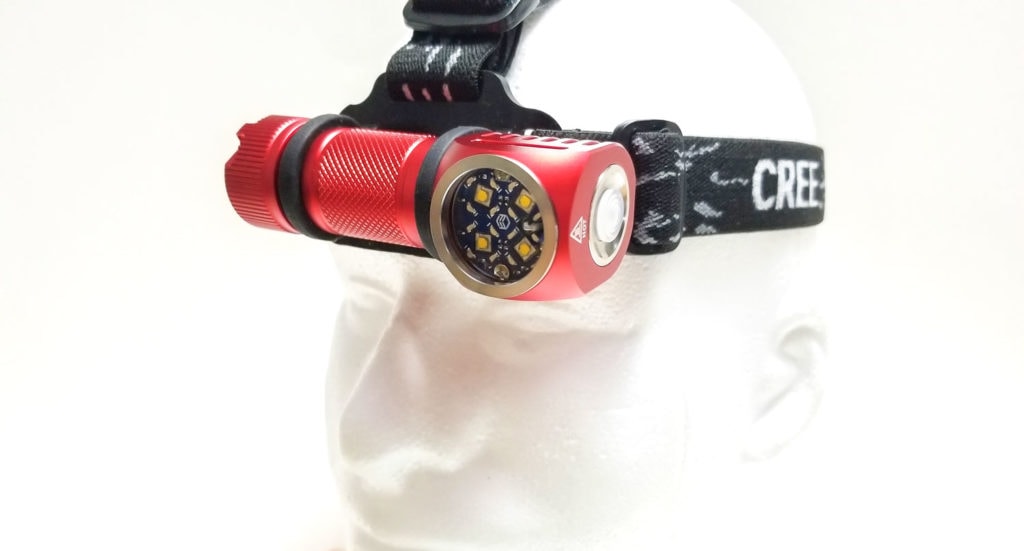
FireFlies PL47MU Mule specifications
| Brand/model | FireFlies PL47MU (Mule) |
|---|---|
| LED | 4x Luminus SST20 FA3 4000K 95 CRI |
| Lumens | 2,800 lm |
| Beam intensity | N/A |
| Battery config. | 1*21700 / 1*22430 |
| Material | Aluminum |
| Modes | Many! Runs Anduril |
| Blinkies | Many! Runs Anduril |
| Reflector | None |
| Waterproof | IP68 |
| Review date | September 2021 |
Introduction:
It had been pretty quiet over at the FireFlies camp of late, and they hadn’t released many new flashlights in recent months since the reboot of the PL47G2, the 90-degree EDC/headlamp/worklight flashlight in 2019. However, they have since released some new, very nice lights of late, including the E07X, Fireflies E12R, Fireflies NOV-Mu 21 mule with Nichia E21A emitter, and the throwy ice cream cone FireFlies T9R with SBT90.2. All nice stuff. I reviewed the revamped FireFlies PL47G2 2021 edition, and found it to be a unique, multi-role flashlight. Maybe FireFlies felt the NOV-Mu 21 needed a stablemate because now there’s a mule version of the PL47G2.
For those who don’t know, a “mule” is not the result of a donkey and a horse gettin jiggy with it, but a flashlight without optics or a reflector. These are obviously good for lighting up a large area (like for photography) or for applications where glare or reflection from a focused light source (e.g. hotspot) would be undesirable. Throw? Maybe, but again, these are for lighting up rooms. FireFlies pairs the mule with just 2 emitter choices, but you still get the Nichia 219b SW45K as an option (along with the familiar FA3 SST20). Let’s see how an optic-less PL47G2 gets on. Note, the PL47G2 with optics and the mule are basically identical, so there may be some parallelisms from that review.
Package quality.
The PL47 Mule came in a nice, premium-looking package. The outside of the box is pretty spartan, with just the branding and a sticker on one end with the build date, emitter type, body color and a quality inspector mark. The review light came nicely kitted-out with optional extras, so I probably got more than the average buyer would get. The light itself was nestled in dense foam at the bottom, with the accessories riding on top.
- FireFlies PL47 Mule (with optional 22430 tube installed)
- 2 spare o-rings for the short and 21700 tubes
- 22430 li-ion cell (installed in the light)
- UI manual
- Pocket clip
- Lanyard with quick-release clip
- Headlamp headband
- 21700 tube
This is a really nice assortment of accessories, and the optional extras are a very nice addition. Depending on how you bundle this (with short tube+battery or 21700 tube, with or without battery), you get everything you need. The accessories are just okay and FireFlies didn’t waste any money on them. The lanyard seems cobbled together, like they melted the cut ends and fused them and kind of junky looking.
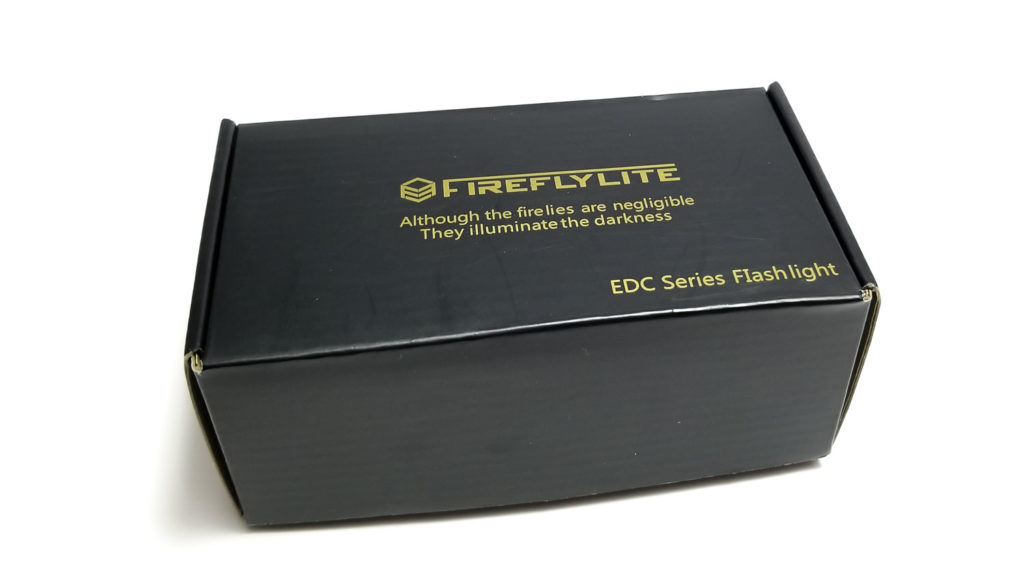
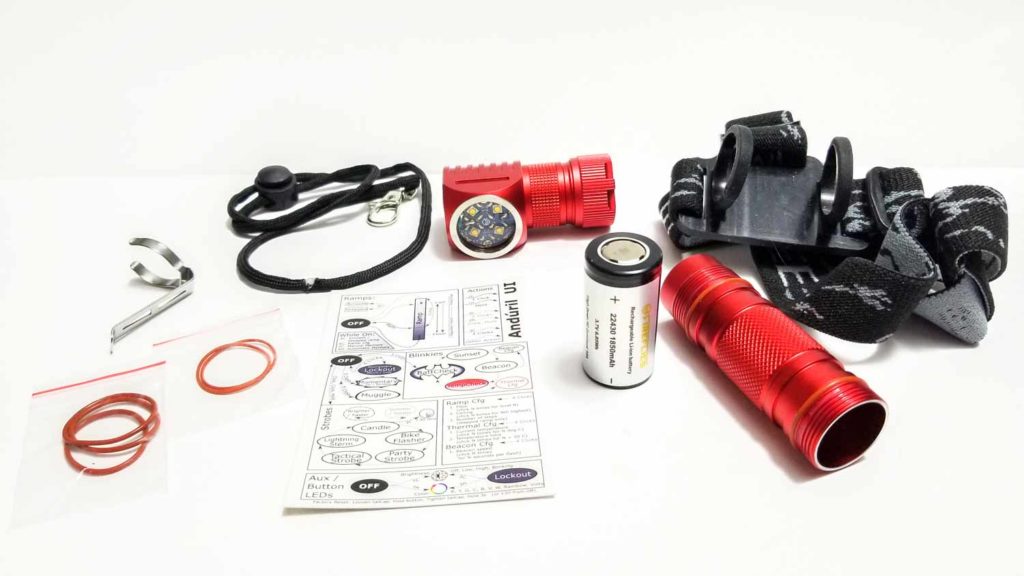
Flashlight in use
The Fireflies PL47G2 Mule is a right-angle EDC light, but also functions as a headlamp (the headband and mount are included). As a handheld flashlight, it’s nice to hold, and I found the best way was holding it in a pistol grip of sorts, with your thumb resting on the top of the head (where the switch is located). With the short 22430 tube installed, it’s easier to handle than the optics version since the head is shorter and lighter, and not so front-heavy. It also fits in the pocket better and feels less bulky.
You’re still restricted to holding it with a 2 finger grip on the short tube, but switching to the 21700 tube allows a full grip. The head has some shallow heatsinking fins, and the battery tube has diamond cut knurling that’s not very aggressive, but still grippy. The tailcap has fine vertical reeding for grip. The e-switch is mounted on the top of the head, and the click action is good, with positive clicks and good feedback with a low action. It’s mounted in an indentation surrounded by a polished aluminum bezel (which accentuates the red finish), so finding it is super easy. It’s also backlit by 4 white SMD LEDs. When the light is off, all 4 are illuminated, but when on, only 2 are illuminated which I really liked.
The 21700 tube has grooves milled in for an optional pocket clip, which can be mounted to the tube for bezel up or down pocket carry or clipping to clothing or gear. The 22430 tube however, has no grooves, so unfortunately you can’t use it with the clip. You can attach a lanyard to the tailcap, which has an appropriately-sized lanyard hole. The included headband setup is nice, although the band is a bit flimsy. It does have a top strap that helps with stability if using it on a helmet. The headband mount is made of soft silicone and has 2 circular openings that fit into the grooves in the tube. A major drag here is the 22430 tube is not compatible with the headband (too short). Fitting the tube into the mount is tricky since you kind of have to finesse it in there, but once installed, it works fine. The headband is comfortable to wear and the PL47 rotates freely 90 degrees up or down in the mount.
The tailcap has a pretty stout magnet in there that grips the battery and helps pull it out of the tube, as well as holding the light at a 90 degree angle with good stability. Tail standing is more stable with the mule version since it’s not as top-heavy. I am usually NOT a fan of magnetic tailcaps on EDC lights since anything magnetic in your pocket sticks to it, but I am really digging the usefulness it adds to the PL47, especially as a worklight when you need your hands free.
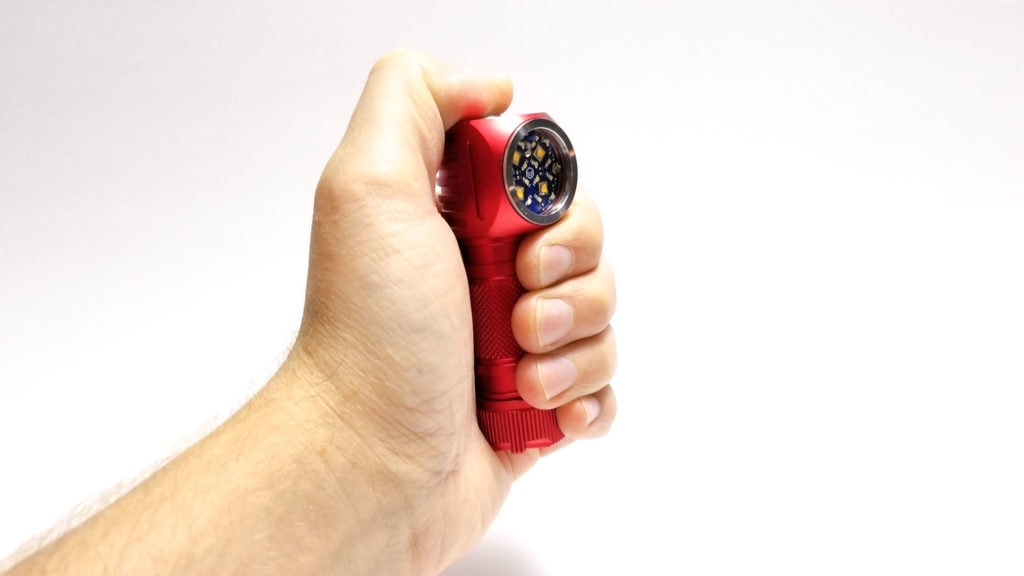
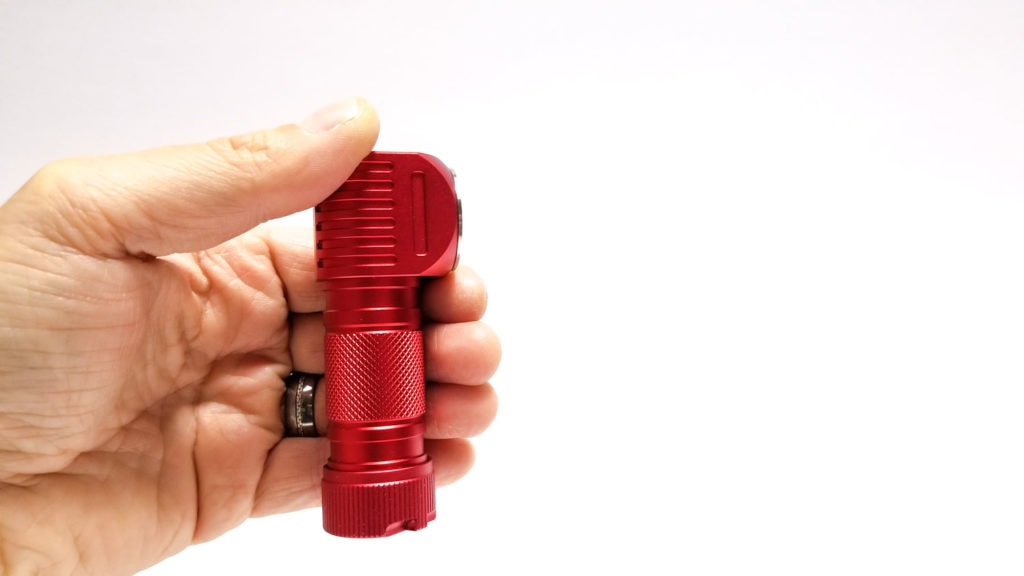
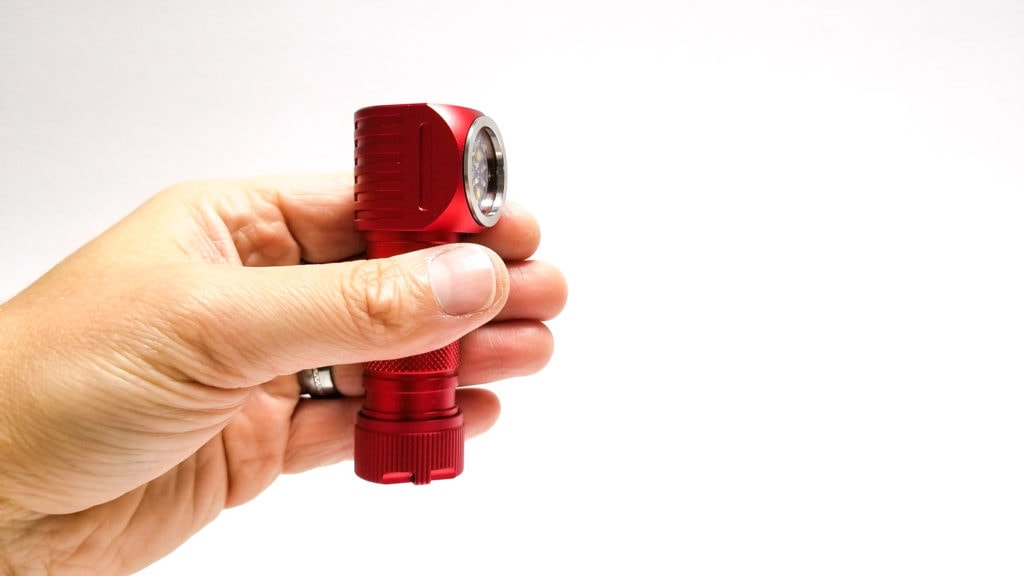
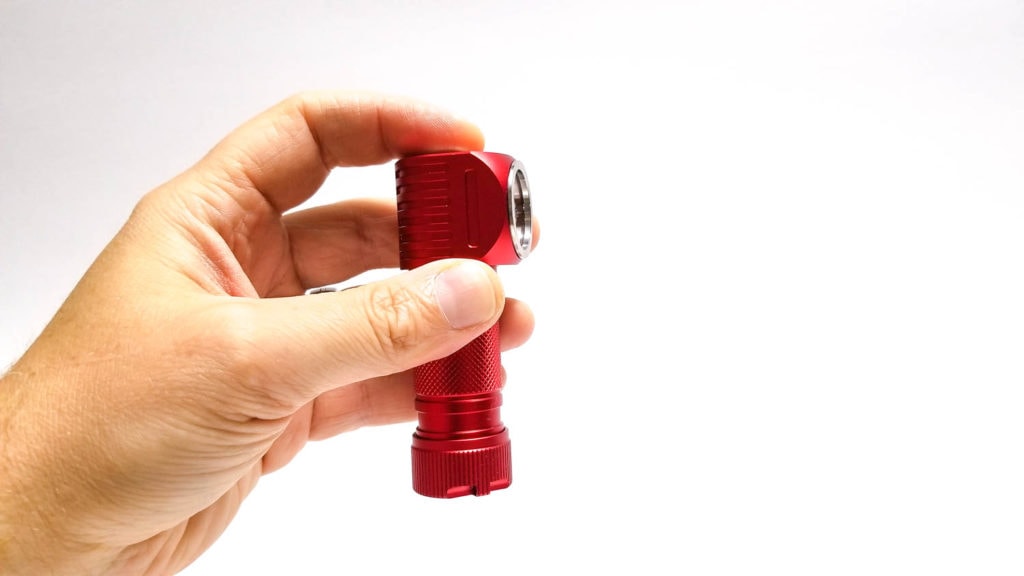
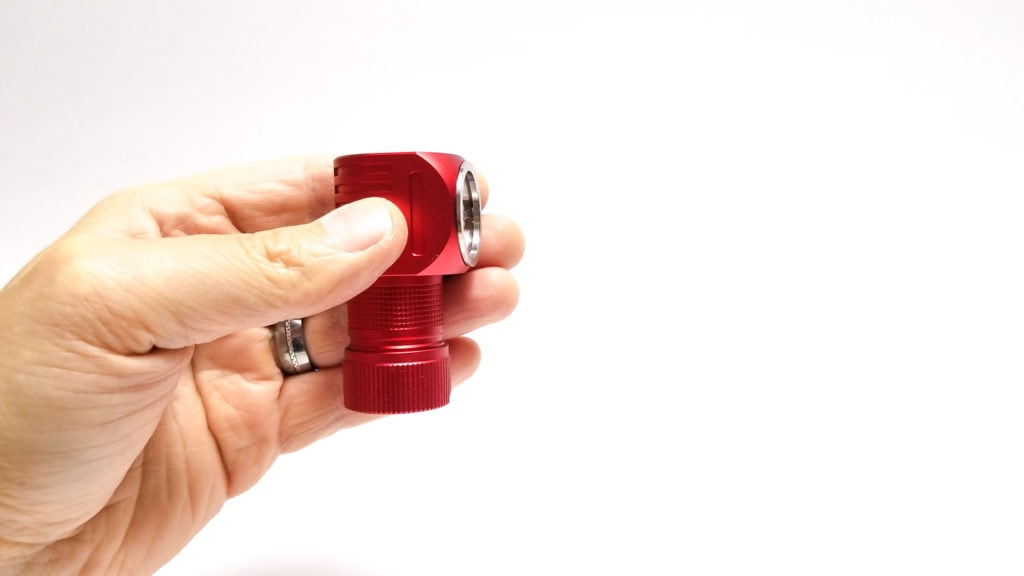
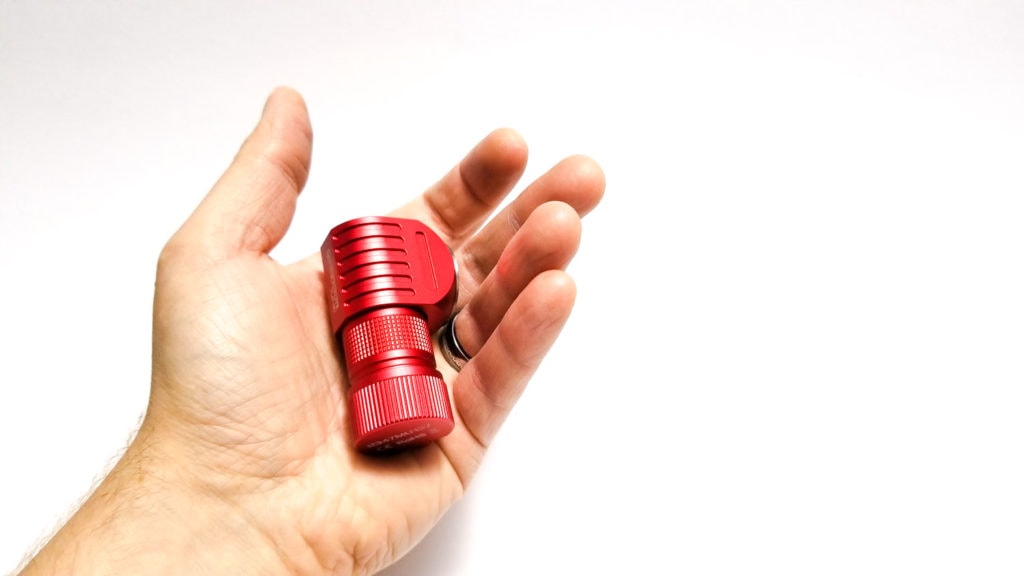
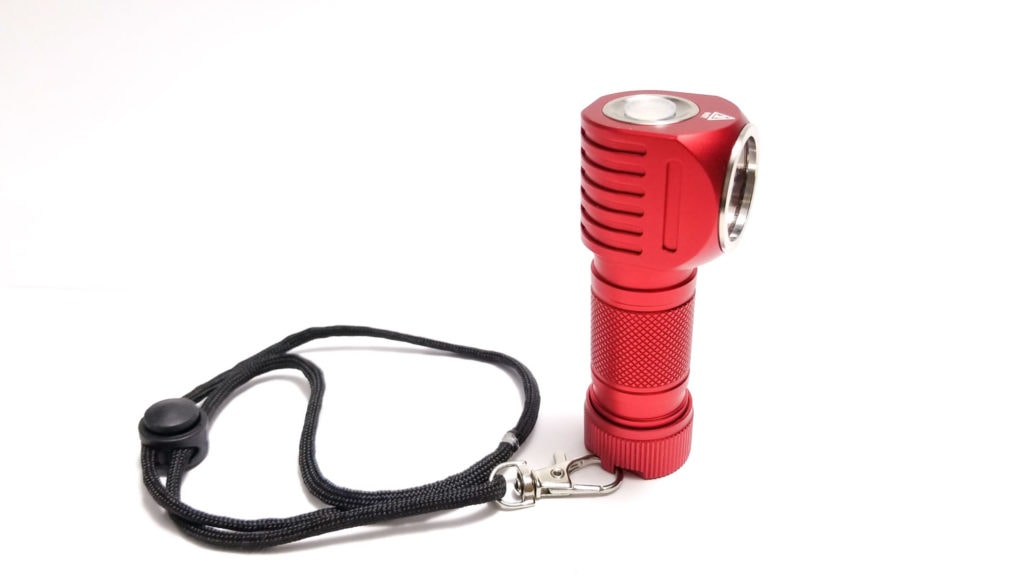

Build Quality, and Warranty
Like the regular PL47G2, the fit and finish are commensurate for the price. The body is made from 6061 aluminum alloy, and the build quality is nice. The machining had no tool or machine marks, chips, or blemishes, and all the parts fit together fine with no gaps. The texturing on the battery tubes is nicely done, and the reeding on the tail cap is nice. There’s no sharp edges either. You can get the PL47G2 Mule and optic version in black type III HA or red anodizing. My sample came in red, and It’s mix of matte and semi-gloss, and less matte than the black version. However, it’s nicer than some other semi-gloss or glossy finishes.
The only removable part is the battery tube and tailcap since the bezel seems pressed on. There are o-rings sealing the bezel, and thick o-rings sealing both ends of the 21700 tube. For some reason, FireFlies opted for smaller o-rings on the 22430 tube, and apparently, this is good enough for an IP68 rating. The threads are nice square-cut deals on both ends of the battery tubes. One interesting feature is the part that threads into the head has a long, unthreaded section that contacts the driver. My guess is this helps with heat sinking to pull heat away from the driver and head. Like on the optic version of this light, some of the threads on the tubes were lubed with a very thick, pasty grease, but some were bone-dry along with the o-rings. Make sure to add some silicone lube for added smoothness and o-ring longevity. The springs on the tailcap and driver look to be high current BeCu that FireFlies is putting on their lights these days, so that’s a nice touch.
While not as robust as other higher-end manufacturers, FireFlies warranty is still pretty good. From the website: “We provide 3 years’ manufacturer warranty to fireflies flashlights. (Consumable batteries are not in warranty). DOA products can be returned and refunded within 15 days, We will bear all the returning shipping cost.”
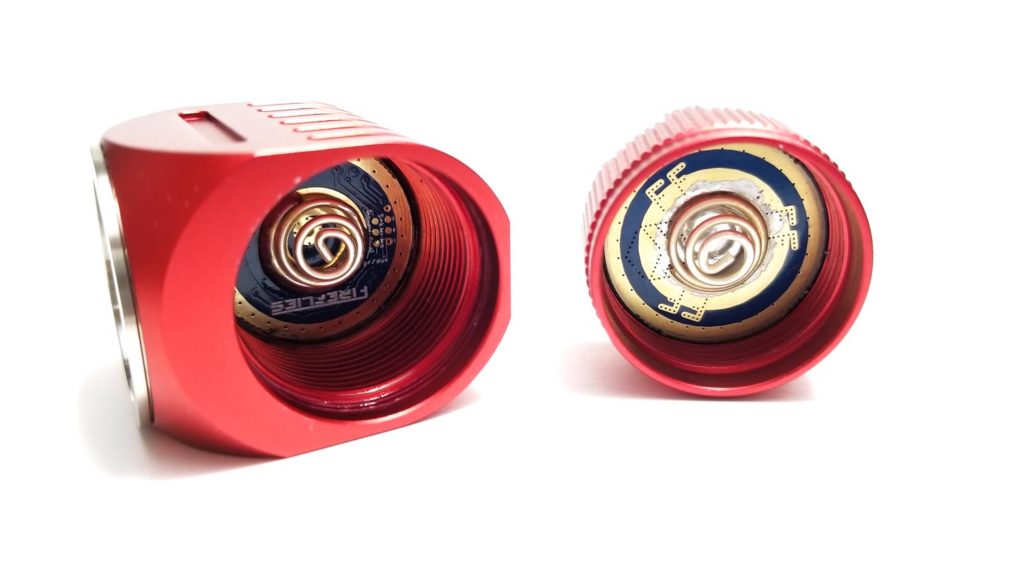
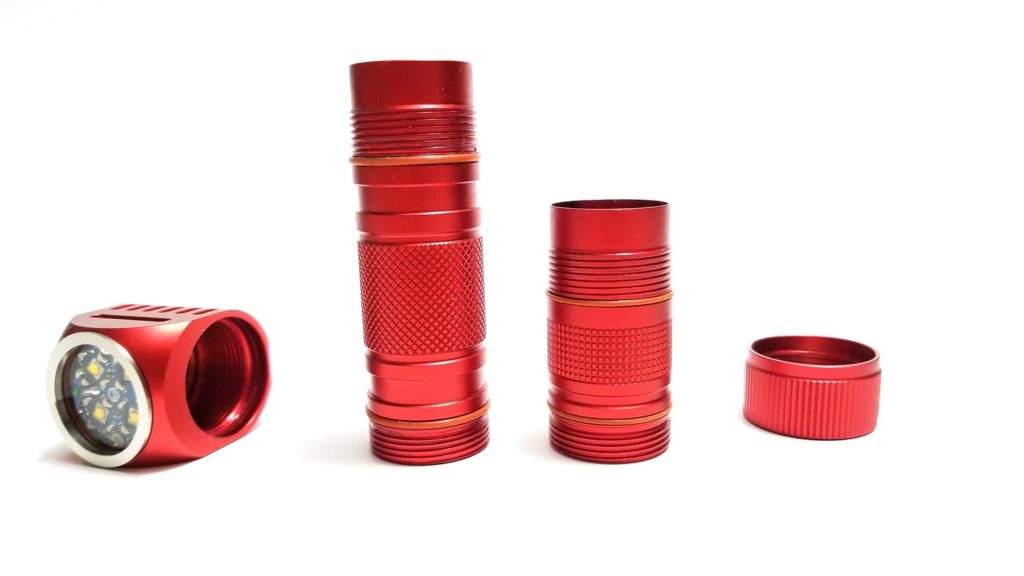
LED, Lens, Bezel, and Reflector
Being a mule, there’s no optics or reflector, just a lens covering a quad MCPCB. Honestly, it looks neat with the exposed blue MCPCB, wiring, and bare LEDs.
It reminded me of Darth Vader when Luke took off the helmet. Unlike the optic version which has optional Cree XP-L HI and 5000K 10W SST20 emitters, there are only 2 emitter choices with the mule: The Luminus SST20 FA3 4000K 95 CRI or the tint-snob’s favorite Nichia 219B D220 SW45K 4500K. Like the optic version, the mule came with the FA3 SST20. Interestingly, the mule’s FA3’s were a bit warmer to the naked eye and less rosy, which I liked better. Maybe I won the tint lottery on this one? I also noticed slightly higher output with identical batteries. These LEDs are not green at low current unlike the 5000K variety.
For the red body, you get purple aux LEDs. The bezel is a small stainless steel ring with the lens recessed about 1.5 mm to protect it from drops. The lens doesn’t seem to be AR coated this time. Beam? The SST20 is a pretty throwy LED, but with no optics, it’s all flood with minimal throw. There’s some, but I estimate it’s limited to maybe 40-50 meters of usable light. So, what do you use a mule for (besides helping Clint Eastwood transport Sister Sara across the desert)? This is mainly for lighting up a large area where a focused beam isn’t practical, and it does good at that, with nice even light distribution. The high CRI and nice tint really helps bring out certain warm colors, and for mechanics or service techs, this could be useful for finding certain leaks or defects in parts. For painters or auto body technicians, it would be useful for color matching and blending. I used this when doing some work on my car and it’s really nice as a drop light with the magnetic tailcap and very nice tint and, clean, even light distribution.
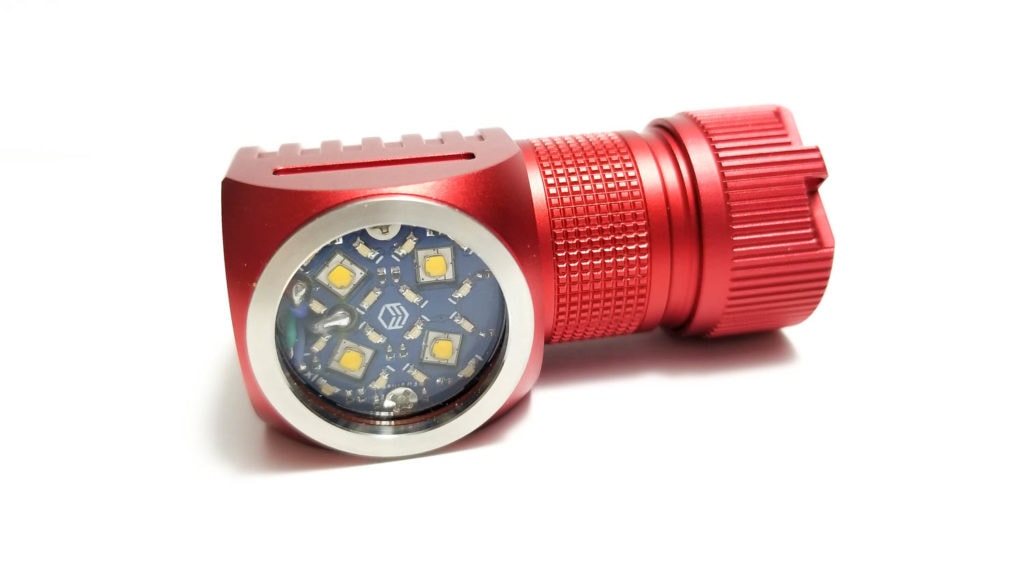
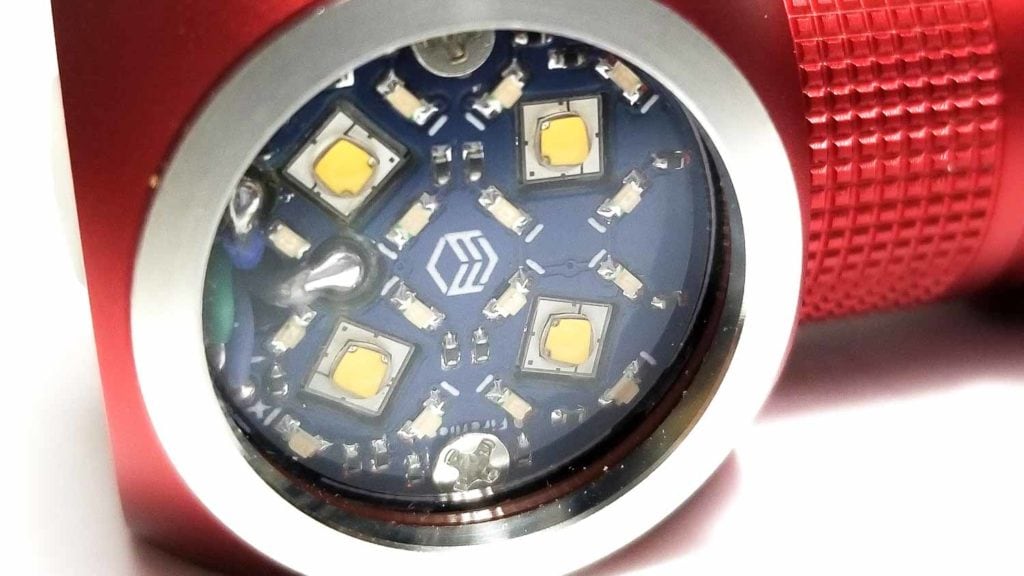
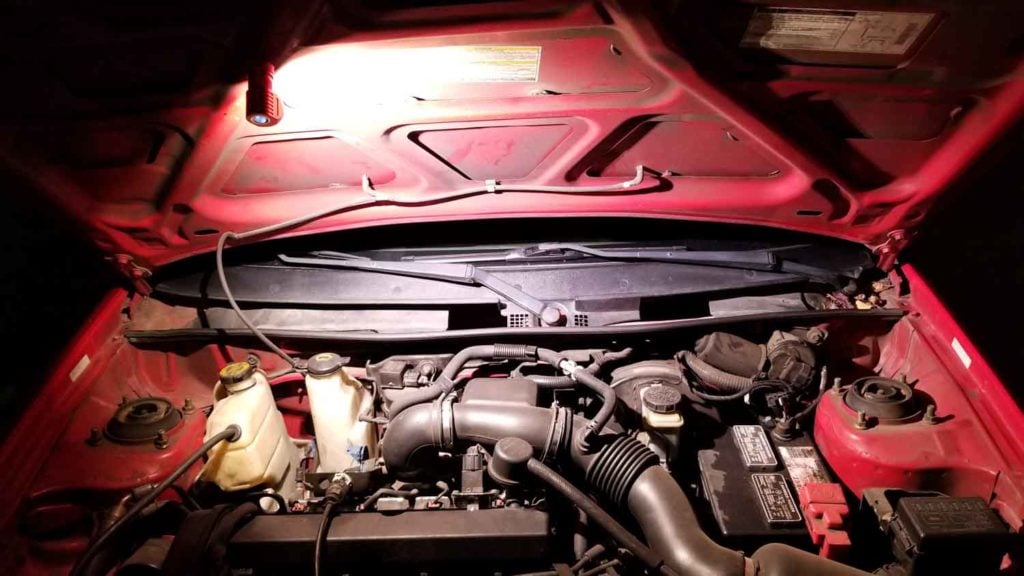
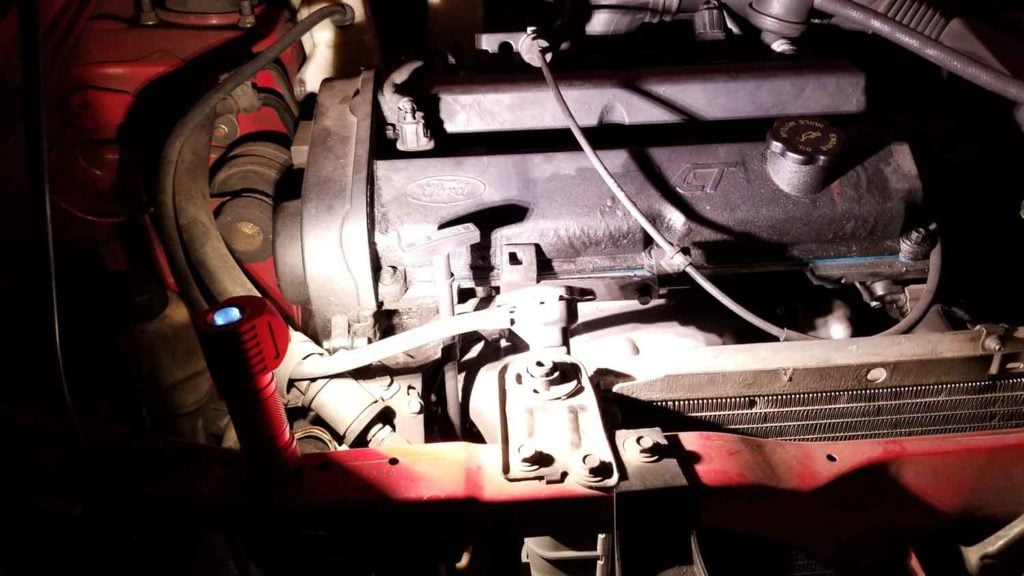
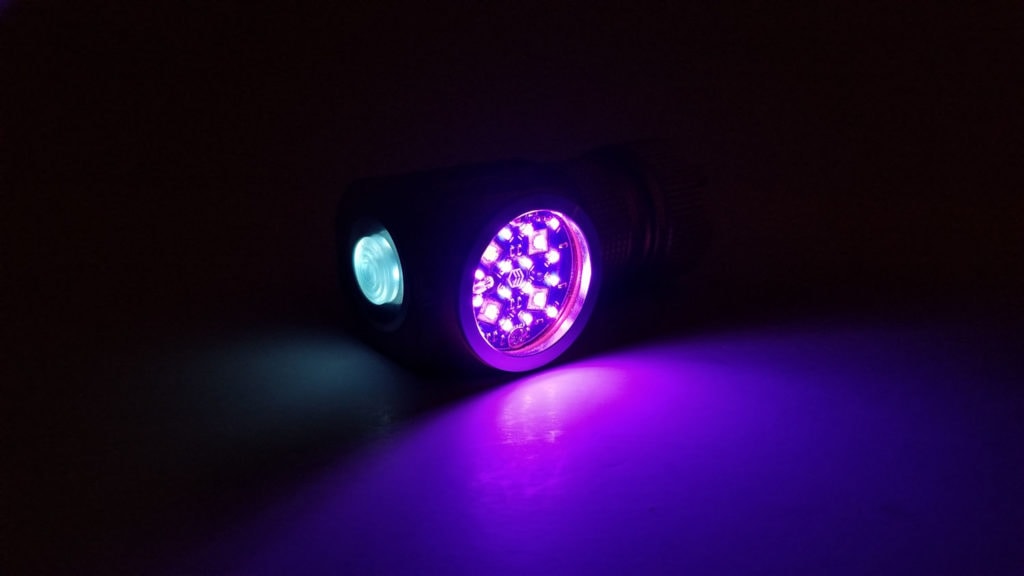
Dimensions and size comparison
- Length with 21700 tube: 8.9 cm / 3.14 inches. With 22430 tube: 6.45 cm / 2.53 inches
- Height: 3.4 cm / 1.33 inches
- Width (body): 2.8 cm / 1.10 inches
Weight:
- 22430 tube without battery: 66 grams / 2.32 oz.
- 22430 tube with included 1850 mAh battery:107.5 grams / 3.79 oz.
- 21700 tube with Epoch 50G 21700: 141.8 grams / 5.0 oz.
- 21700 tube without battery: 72.7 grams / 2.56 oz.
Flashlight size comparison
Compared the PL47G2 mule to some other great headlamps and EDC lights.
Headlamps left to right: FireFlies PL47G2 mule, Slonik D10, Cyansky HS6R, FireFlies PL47G2
Group 2 EDC lights left to right: Lumintop FWAA, FireFlies PL47G2 mule
Group 3: Astrolux EC03, PL47G2 mule, Astrolux EA01.
Group 4: Astrolux EA01 short tube, PL47 mule short tube.
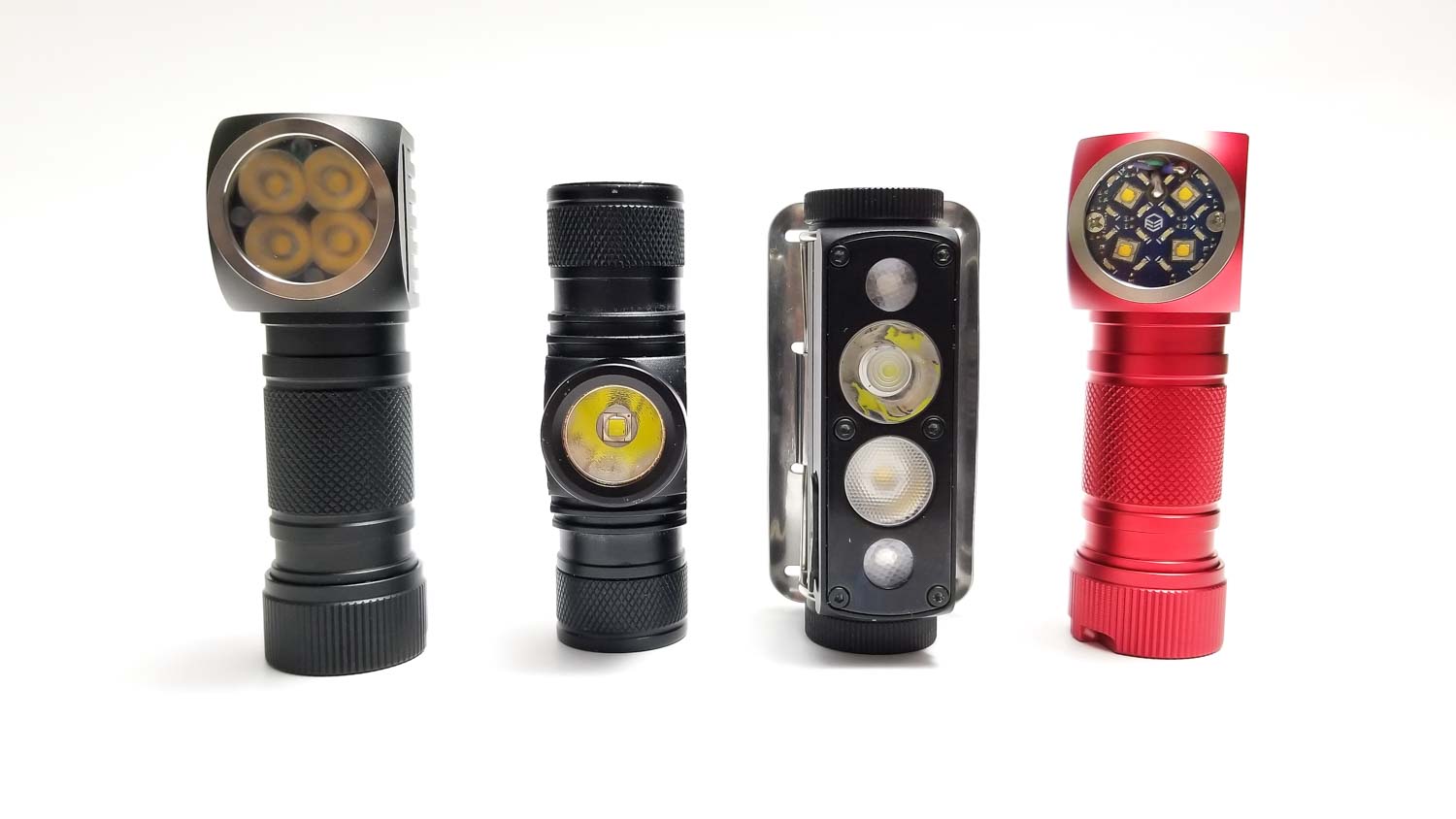
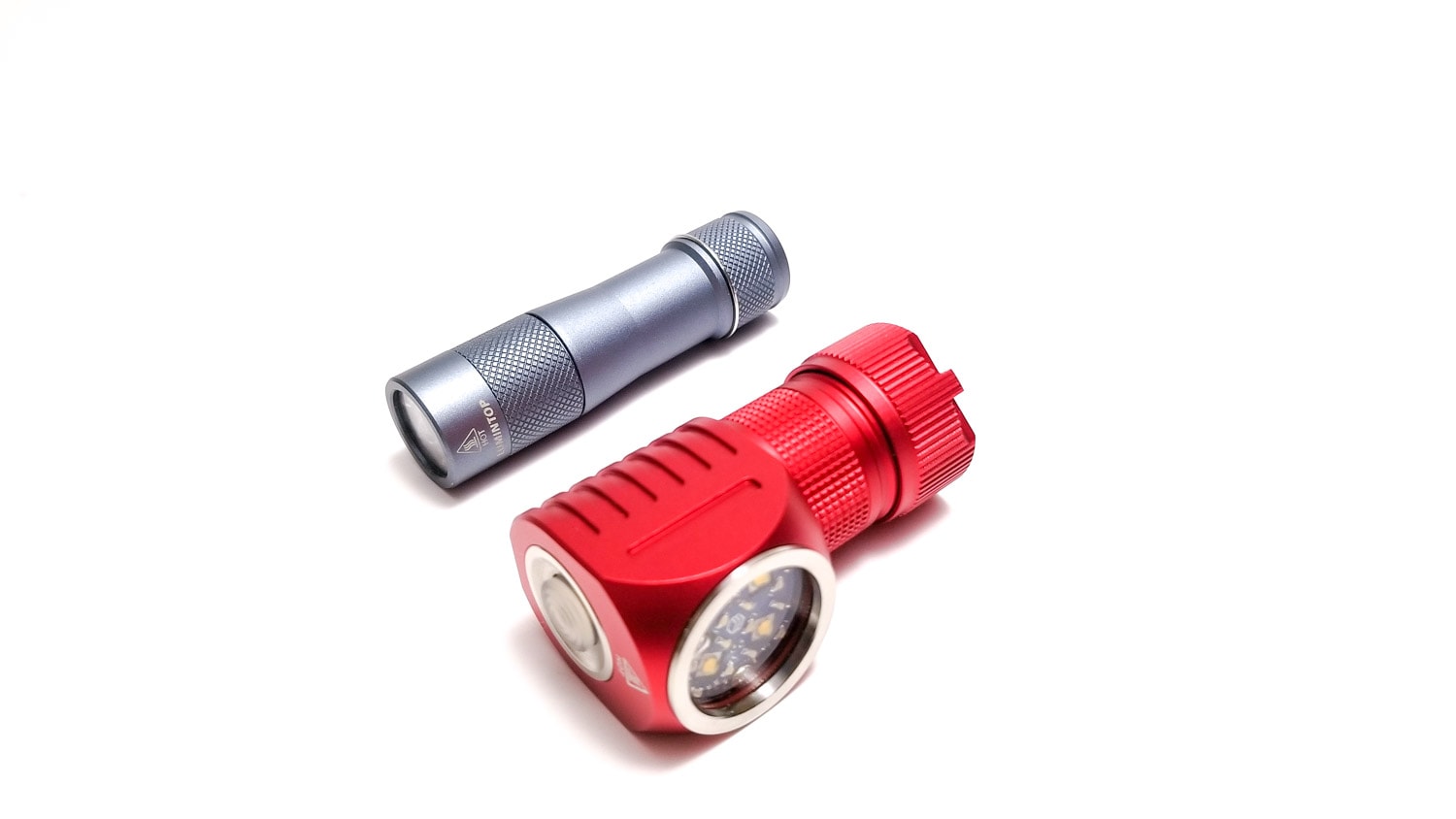
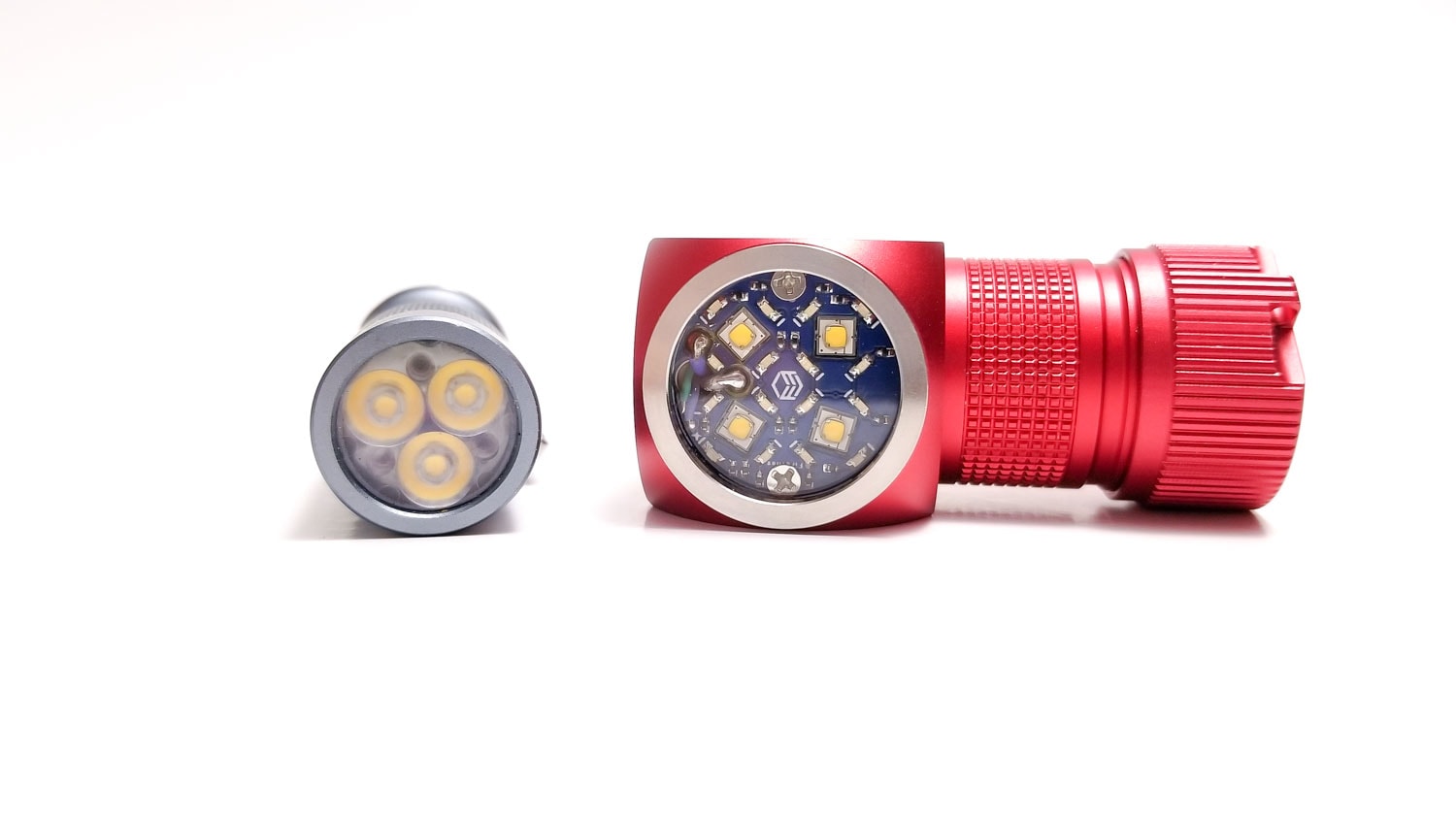
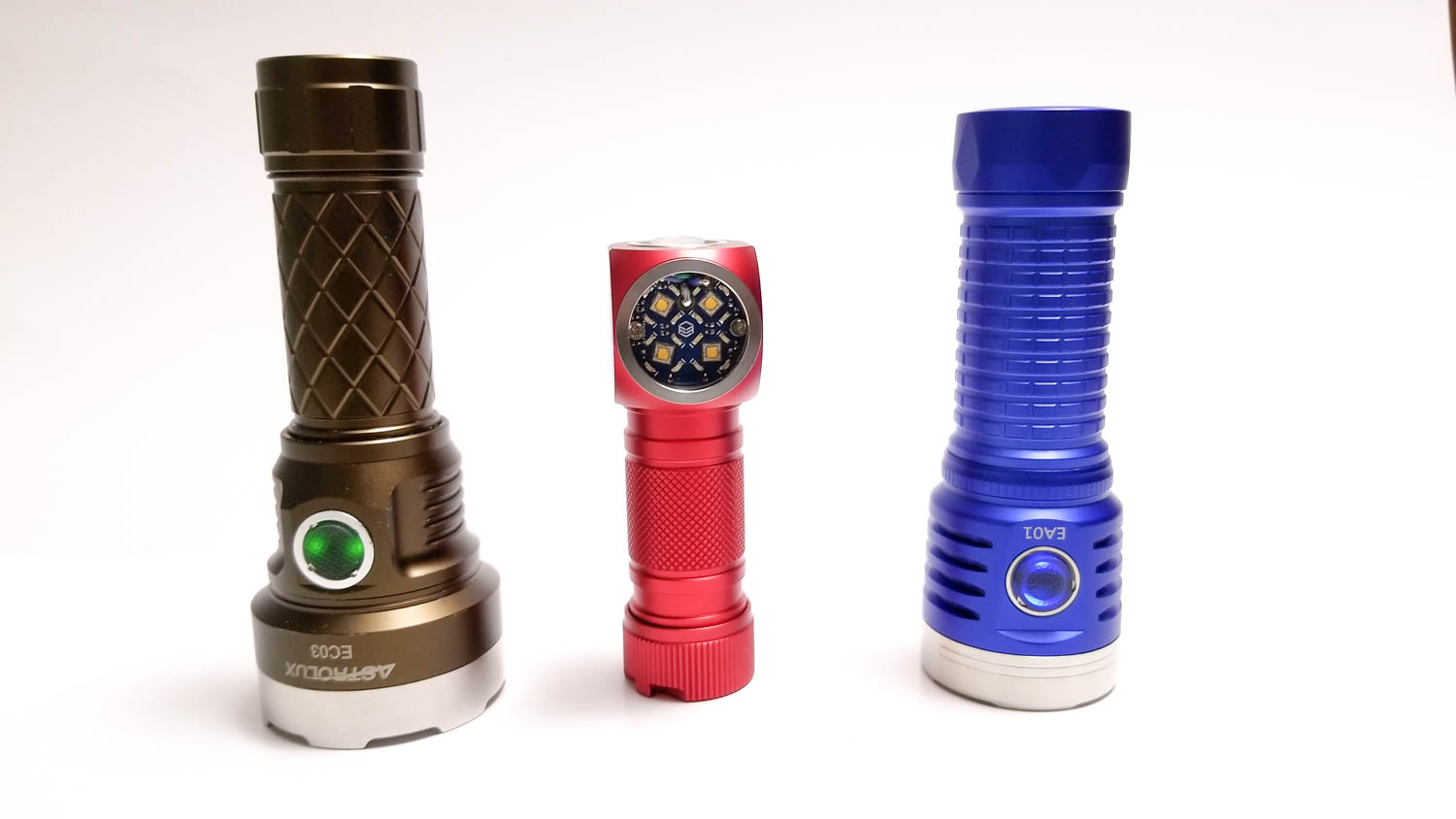
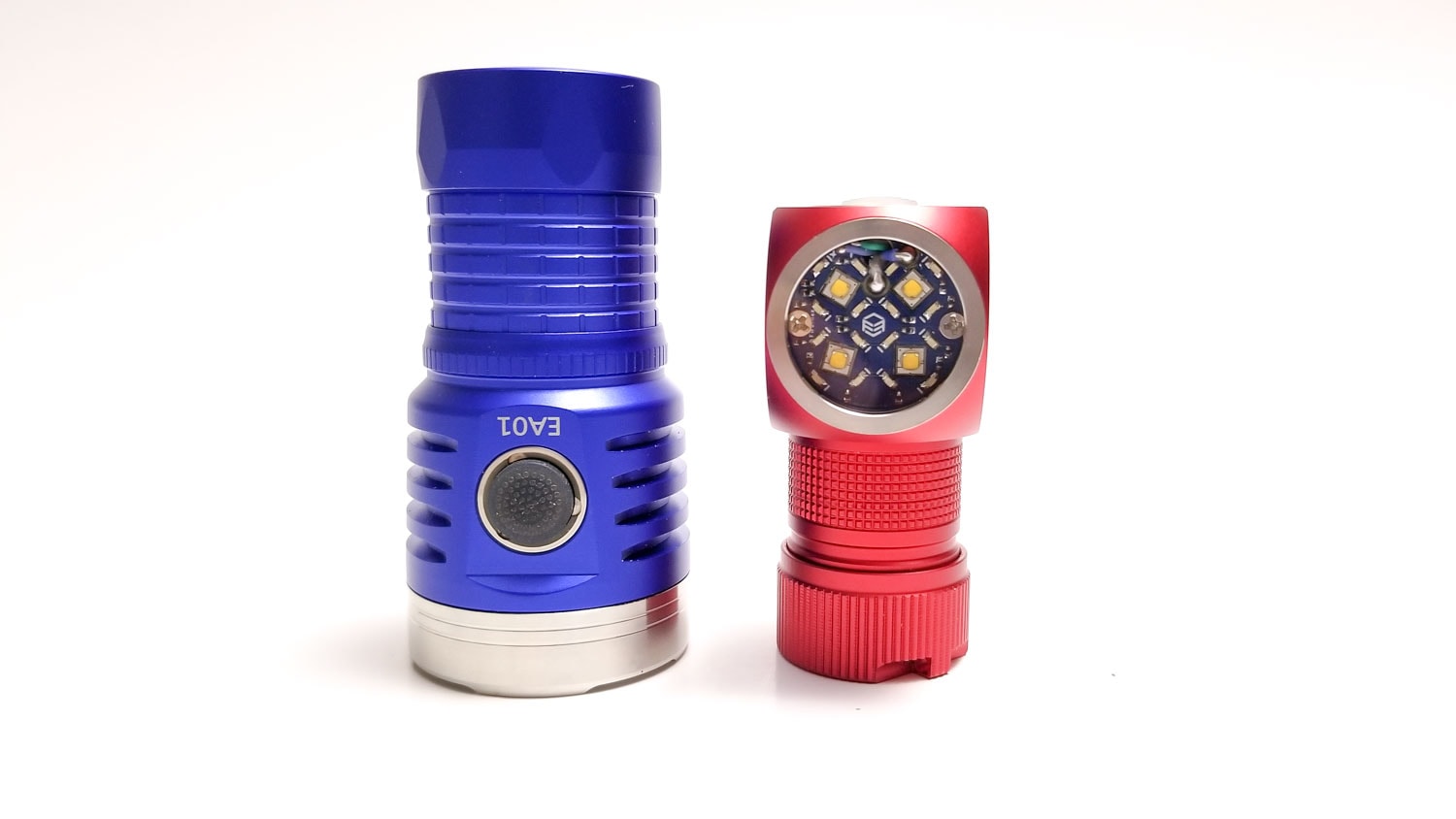
Driver & User Interface:
Since I can’t open up the mule, I can’t tell you what’s under the hood, but it’s probably an FET+1 driver, so you get all-out direct-drive on Turbo, and regulated output on lower modes.The driver is FireFlies design and looks to be 20 mm in diameter.
By default, it uses a smooth ramping mode.
Check out the full Anduril UI manual here.
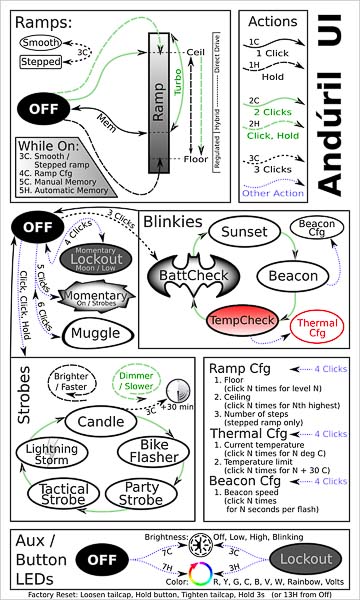
Keep in mind that the AUX LEDs are on by default. (7 clicks from OFF can change the AUX settings from On – Blink – Off)
From OFF:
- Single-click: ON
- Double click: High
- 3 clicks: Battery check
- 4 clicks: Lock Out
- 5 clicks: Momentary On
- 6 clicks: Muggle mode
- 7 clicks: Aux configuration mode
Enter Special/Fun modes from OFF:
- 2 clicks + hold: Strobe modes (Click, Click, Click and hold)
- 4 clicks: Lock Out mode (momentary on: dim)
- 5 clicks: momentary mode (Bright) ( you can only deactivate by breaking electrical contact between the batteries and the driver by unscrewing the body from the head.
- 6 clicks: Muggle mode
From ON:
- Single-click: Off
- Double click: Turbo
- 3 clicks: change ramping mode. Instead of a smooth increase, it has 6 little steps between Low and Max.
- 4 clicks: ramping configuration mode (Problematic if you make some changes here by accident)
- Press and hold: brightness ramps up.. release and press and hold again to ramp down.
SPECIAL AND FUN MODES:
Read the full manual on how to access and customize these modes. Also, see the firmware picture.
- Blinky Utility mode:
- Battery check
- Sunset Mode
- Beacon mode
- Temperature check
- Strobe / Mood modes:
- Candle
- Bike flasher
- Party strobe
- Tactical Strobe
- Lightning mode
- Lockout mode (can’t use the light) (activate by 4 clicks)
- Momentary mode (signaling/morse coding)
- Muggle mode: (safer for children)
- Configuration mode
- Ramp config mode
LOCK OUT FEATURE:
- From OFF: 4 clicks. To deactivate click another 4 times.
Additional info: Even though I like simple UI’s, I think Anduril is a good choice for the PL47G2 mule. This is an enthusiast light so having the added customizability and feature set Anduril gives will appeal to a lot of users. It just works great and has a lot of features. Some like that, some don’t. I was expecting the thermal calibration to be off, and it was, but not as bad as some other Anduril lights I’ve come across. That said, you still want to calibrate it since the ambient temperature was a little low (maybe calibrated in a cold room?). I left it as-is for my tests since it wasn’t off much. The added benefit of Anduril here is apparent in the aux LEDs, namely, you can customize them (on or off, blinking, etc.). It also adds infinite brightness adjustment with Anduril’s excellent smooth ramping.
Batteries & Charging
The PL47G2 was designed around a 21700 size li-ion cell, but the 2021 edition introduced the short tube and the oddball 22430 lithium ion cell. At 22 mm in diameter by 43 mm long, it’s bigger than an 18350 with a little more capacity and about the same current-handling. FireFlies includes their high-drain 22430 cell advertised at 10 A discharge and 1850 mAh. The smaller cell will work fine, but if you want the most out of the light, the 21700 cell has more capacity and current-handling capability. Like I found with the optic version, the 22430 cell is more for handheld use, since the short tube doesn’t work with the headband. Flat top and button top 21700’s worked, but protected cells are too long. 18650’s (save 70 mm long ones) don’t work.
There’s no onboard charging, so you need a standalone charger. Pro tip: Any charger that works with a 16340 will work with the 22430 size cell, but keep the charge current at 1 amp to keep it happy (and living a long time).



Performance
I set the thermal limit to 70 C (maxed out) for the testing to eliminate thermal throttling as a variable for the output. I’m expecting near identical behavior to the optic version of this light, so fast stepdowns and rapid heating.
Runtime graph
I conducted the runtime test using the 30-centimeter integrating sphere with the Digi-Sense 20250-00 data logging lux meter. I used the fully charged Epoch brand (rewrapped Samsung 50G) 5000 mAh 21700 battery and tested stepped modes 4, 6-7, and Turbo. I left out 5 because the readings were nearly identical to Level 6.
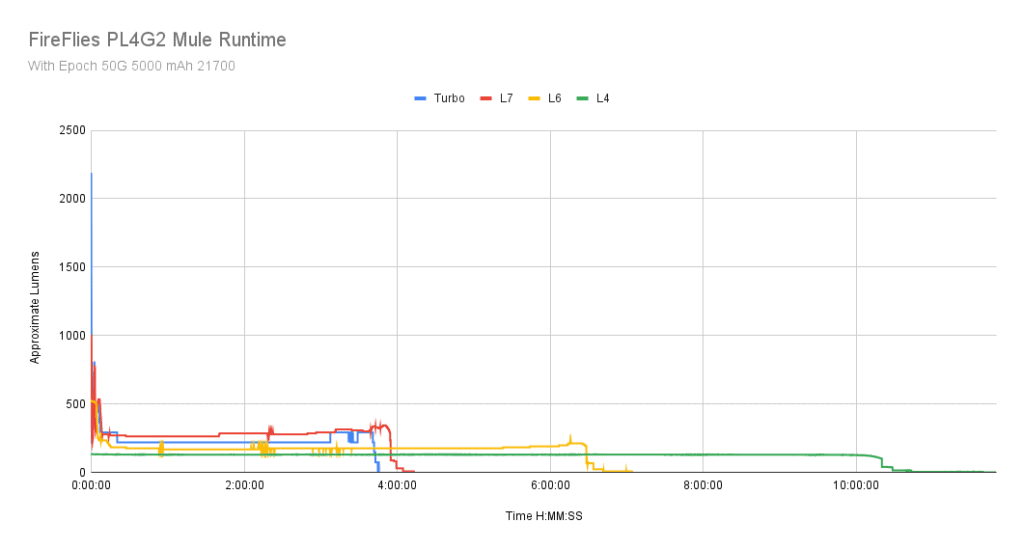
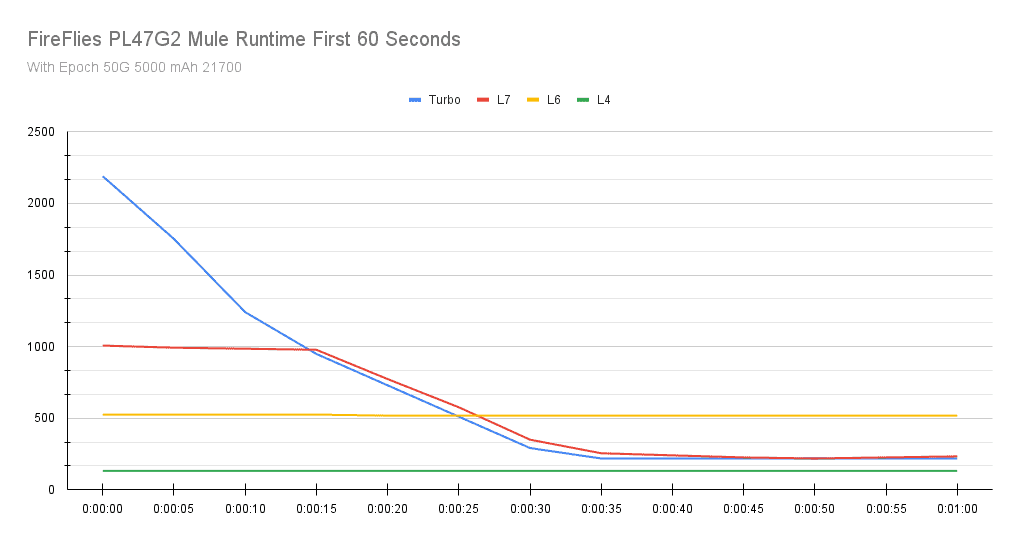

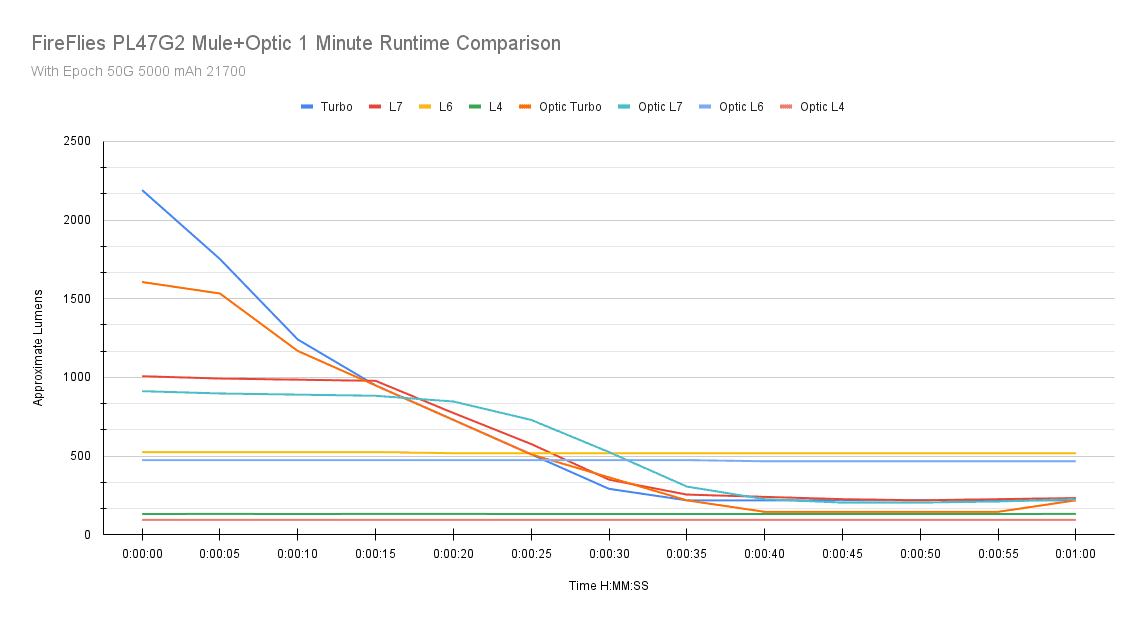
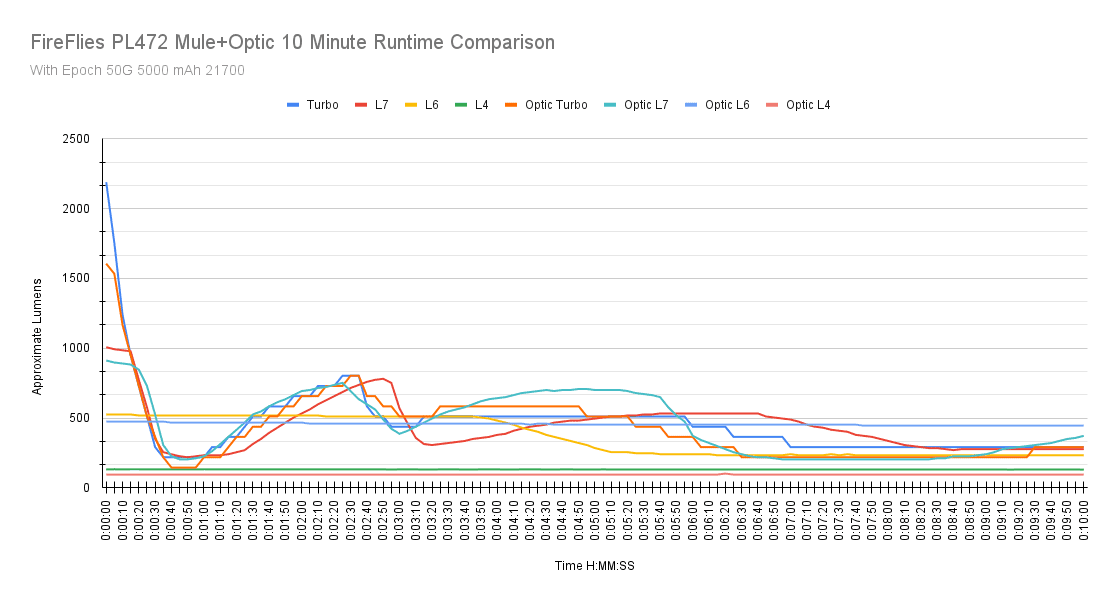
Turbo started at 2190 Lumens, down from the FireFlies advertised of 2800, but a lot higher than the optic versions 1606 Lumens. As expected, it heated fast, up to 33 C from 24 ambient in 5 seconds, 40 C within 10 seconds, and up to 50 C by 20 seconds. The temperature regulation worked fine, adjusting the output to 803 Lumens by 2 minutes 35 seconds (identical to the optic version). At 7 minutes, the output dropped to 292 Lumens, with a slight drop to 219 Lumens until LVP kicked in at 3 hours 42 minutes down to 146 Lumens, then down to a very low level when I ended the test at 3 hours 46 minutes. By comparison, the optic version lasted 2 hours 28 minutes. Temps were also a bit lower, only hitting 65 C max.
Level 7 started at 1000.7 Lumens (vs. 912 for the optic version), stepping down by 219 by 50 seconds, and throttling up again like Turbo. It briefly hit 781 Lumens at 2 minutes 50 seconds, but generally was between 299 and about 306 Lumens until the 4 hour 4 minute mark when LVP pulled the plug and dropped the output to about 7 Lumens and I ended the test at 4 hours 13 minutes. Interestingly, the light didn’t reach the thermal limit, and like the optic version, only hit 58 C.
Level 6 started at 525 Lumens (vs 474.5 for the optic version), and was much more consistent, but the temperatures were nearly the same as Turbo and L7, it just heated up much more slowly (36 C vs 50 C for Turbo at 30 seconds). The output remained consistently over 500 Lumens for the first 3 minutes, 50 seconds vs. nearly 13 for the optic version, but stepped down to under 300 Lumens by 5 minutes, and gradually decreased to under 200 Lumens for about the next 5 hours. There was a ramp up at 6 hours 13 minutes to 211 minutes, but LVP dropped the output low at 6 hours 41 minutes, and I ended the test 24 minutes later at 7 hours 4 minutes. Interesting.
Level 4 was downright boring (just like the optic version). I usually let these tests run all day and night. Output started at 132 Lumens (vs. 94 for the optic), and stayed between 129 to 120 Lumens for over 10 hours, and LVP really kicked in at 10 hours 17 minutes, dropped the output very low (to the same level as the other modes), and I ended the test. Heating? Not really, I only saw a max of 38 C. I terminated the test after 11 hours and 39 minutes. For comparison, that’s an hour longer than the optic version.
This is typical FET+1 driver and small host behavior. Heats up quickly and throttles like crazy at high modes, with long, regulated runtimes on the 7135 chip. Turbo is good for short runs, so like other pocket quads (and like the optic version), the mule is still a 300-400 Lumen light. Now, the elephant in the room. I compared the graphs for the optic and mule runtimes to give an idea of the differences between the two lights. I can only theorize as to the anomalies with the different outputs (and runtimes) despite having the ‘same’ emitters, but either the regular version is losing light out of the optic, or I got some better FA3’s in the mule. The L6 in the optic version did hold a higher output for longer, and that probably accounts for the shorter runtime. I think the output is consistent enough for general purposes, but the penalty is heat. Even using it on L6 for just 5 minutes when working on my car, the light was mighty toasty! Lower modes like L5 would be better for extended use.
Lumen measurements (for each mode)
For the lumen tests, I used my home made 30 cm integrating sphere calibrated with a light of known output using the Digi-Sense 20250-00 data logging lux meter. Amps were measured with my Radio Shack TRMS multimeter with short 16 gauge wires inserted in the meter for currents under 5 amps, and my FY219 clamp meter and a 12 gauge wire loop for over 5 amps. I tested stepped levels 1-7 plus Turbo and used a Samsung 30T to give a good benchmark of the light’s potential. I tried the 22430 cell, and the readings were similar to the 30T until the FET takes over. Level 7 was 4.5 A and Turbo hit 13.8 A at start.
FireFlies doesn’t list Lumen specs other than 2800 for the FA3 SST20 emitters. A firefly (depending on which of the 170 species you sample) makes around 0.025 Lumens.The optic version didn’t do so well with meeting output specs, but interestingly, the mule did better. Hmmmm.
| Mode | Amps at Start | Specs | at start | at 10 Min. |
|---|---|---|---|---|
| 1 | 4 mA | ? | N/A | – |
| 2 | 28 mA | ? | 7.3 | – |
| 3 | 167 mA | ? | 48.18 | – |
| 4 | 467 mA | ? | 135 | 131 |
| 5 | 1.07 A | ? | 277 (284.7) | – |
| 6 | 2.18 A | ? | 496 (525.6) | 234 |
| 7 | 5.88 A | ? | 949 (1051.2) | 277 |
| Turbo | 20.8 A | 2800 lm | 2263 lm (2245.5) | 292 |
Parasitic drain:
1 mA with the aux LEDs on, but only 14 microamps with them off.
Throw numbers:
Throw was measured at 5 meters indoors using the Uni-t UT383S lux meter. I used a Samsung 30T 21700 battery for all tests. Readings taken at 30 seconds. FireFlies doesn’t list throw or candela specs for the PL47G2. Obviously, as a mule, this light is not meant for throw, and the numbers confirm this. In the real world, it’s good for about 125 meters, less if you run it on higher settings for longer than 30 seconds.
| Mode | Specs | Candela Measured | Meters |
|---|---|---|---|
| 1 | ? | N/A | N/A |
| 2 | ? | N/A | N/A |
| 3 | ? | 50 cd | 14.14 |
| 4 | ? | 50 cd | 14.14 |
| 5 | ? | 175 cd | 26.45 |
| 6 | ? | 325 cd | 36 |
| 7 | ? | 700 cd | 52.91 |
| Turbo | ? | 1025 cd (1800 at start) | 64.03 (84.85 at start) |
Beamshots
I compared the PL47G2 to some other headlamps and EDC lights and its mule counterpart (sans optics).
- Outdoor shots: The fence is about 95 meters away. The PL47G2 is good for about 90-120 meters of useful illumination on Turbo, and much less on lower modes. It’s much better suited to EDC-type duties and as a worklight I think.
- Indoors, the end of the hallway is about 12 meters. On the white walls, the tint is really rosy, but in real life it’s more natural-looking. The wall with the map is about 4 meters away. Compared to the PL47G2 optic version, you can see the difference in the beam. Need to light up a 120 square foot office? Grab the mule!
- I did some work on my car at night and used the mule. It works brilliantly for this with the magnetic tailcap and even lighting.








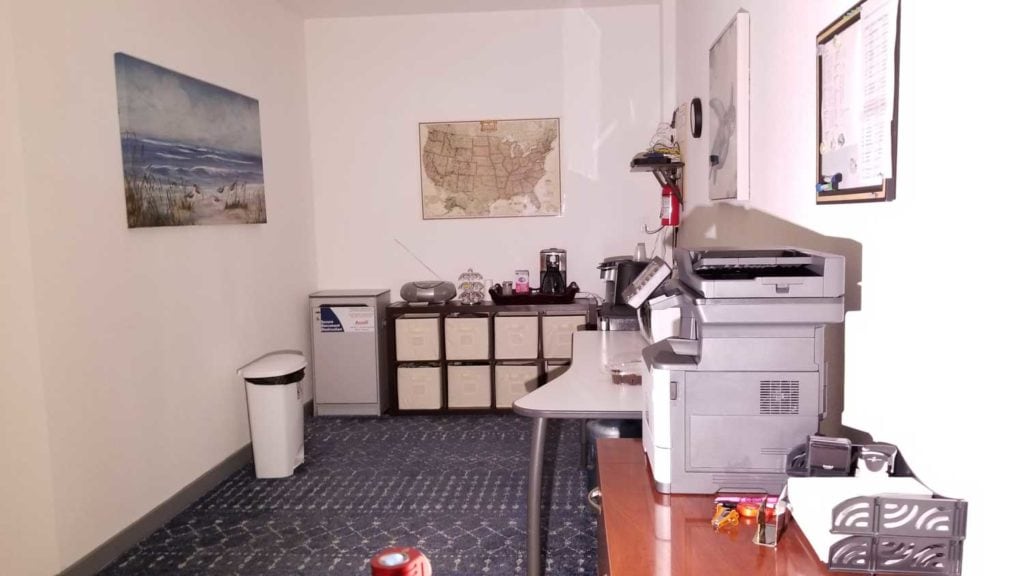

Disclaimer: This flashlight was sent to me for review at no cost by FireFlies. I have not been paid to review, nor have I been holding back on problems or defects.
Final Verdict
Pros
- Nice build quality
- Anduril UI
- Cool aux emitters and lighted switch
- High CRI and nice tint
- Decent output
- Magnetic tailcap
- Very versatile
Cons
- Very fast step down on higher settings
- Included lanyard is wonky
- Short tube doesn’t work with headband or pocket clip
- Anduril UI can be complicated
Explanation on star ratings:
1: Avoid: my phone flashlight would be a better choice – 2: Poor: significant defect or issues, much better options available at the same price – 3: Average: some defects or issues – 4: Good: recommended (minor issues) – 5: Great: highly recommended

4.5 stars: ★★★★⋆
Fresh off my experience with the optic version of this light, I can gladly say I had a slightly better experience with the mule. This is the first proper mule I’ve reviewed, and this has been positive. It’s basically a rerun of the optic version (minus the optic) in a slick red suit, so it’s still versatile, flexible, and will keep the tint-aficionados happy with the optional Nichia emitter. The short 22430 tube relegates it to EDC duty (but no pocket clip? Really?), and it’s awesome as a worklight since the magnetic tailcap sticks to metal things.
Furthermore, the short tube helps it get into small spaces. As a mule, you get all the functionality of the optic-equipped version with slightly better output but less throw (a lot less). You get a slightly smaller profile with the shortened head as well. However, with the good comes the not-so-good. It gets hot fast and steps down quickly with high settings.
I got slightly better output this time over the optic light with longer runtimes, but didn’t see 2800 Lumens from Turbo (even with a 30T). The lanyard (same as the one with the optic light) is still junky looking, although the quality seemed a bit more “stable” on the mule. Overall, a nice light for sure and a good choice if you want a lot of light all over the place. 4.5 stars this time for the PL47G2 mule.
Buy FireFlies PL47 Mule here:
Get 10% off at Firefly Outdoor store, using our exclusive discount code: 1lumen
1lumen selects and reviews products personally. We may earn affiliate commissions through our links, which help support our testing.